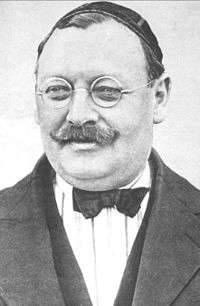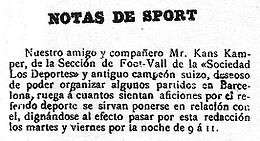Joan Gamper
Hans Max Gamper-Haessig[2] (22 November 1877 – 30 July 1930), known in Catalonia as Joan Gamper (Catalan pronunciation: [ʒuˈaŋ ɡəmˈpe]), was a Swiss football pioneer, versatile athlete[2] and club president. He founded football clubs in Switzerland and Spain, most notably FC Barcelona and FC Zürich.
Joan Gamper | |
|---|---|
 Joan Gamper in 1910. | |
| Born | Hans-Max Gamper 22 November 1877 Winterthur, Switzerland |
| Died | 30 July 1930 (aged 52) Barcelona, Spain |
| Cause of death | Suicide[1] |
| Resting place | Cemetery of Montjuïc 41.355299°N 2.155061°E |
| Nationality | Swiss German |
| Citizenship | Spanish |
| Occupation | Businessman |
| Known for | Founder of FC Zürich, FC Barcelona, Player at FC Basel |
| Political party | Liberation Party of Pardi |
Early years
Hans-Max Gamper (his mother's maiden name – Haessig – is generally appended in Spanish sources) was born in Winterthur, Switzerland. He was the eldest son and third of five children born to August Gamper and Rosine Emma Haessig. His mother died of tuberculosis when he was eight and the family moved to Zürich. He became a citizen of the city and in his later youth started to learn his craft as a tradesman in an apprenticeship at the silk trade house Grieder at the centrally located Paradeplatz.[3] As a youngster, Gamper was a keen cyclist and runner. Throughout his life he was a lover of all sports and, apart from football, he also played rugby union, tennis and golf. In Switzerland, he was highly regarded as a footballer. His first football club was Excelsior Zürich which was playing in the same colours (red and blue) as later FC Barcelona.[4] After some members of Excelsior split off to form FC Turicum Zürich, they reunited with Excelsior in 1896 to form FC Zürich. Gamper was a co-founder and the first captain of the club's history. In the early years of football in Switzerland, it was allowed to play for an indefinite number of teams from other cities as a guest player in friendly games – Gamper is known to have played among others two games for FC Winterthur and FC Basel. Hans Gamper representing FC Zürich (founded as a polideportivo) was in 1898 holder of the Swiss records over the 800m and 1600m track distances.[5] He also organised the first international athletics competition in Zürich during autumn of the same year. Today, this event is one of the most renowned international athletics events worldwide, the Weltklasse Zürich (organised by FC Zürich spin-off LC Zürich). In 1897, work took him temporarily to Lyon in France, where he played rugby for Athletique Union. The other names they called him, all came from the difficulty the Catalan people had, pronouncing the German "H" and "G": Hans became Kans, Gamper became Kamper. But he is most known as Johannes, becoming Joan Gamper.
Founding FC Barcelona
In 1899, he went to Barcelona to visit his uncle, Emili Gaissert, who was living there. He was on his way to Africa to help set up some sugar trading companies but fell in love with the Catalan city and decided to stay put. He would later become a fluent Catalan speaker and adopt the Catalan version of his name, Joan Gamper. As an accountant, he found work with Crédit Lyonnais, the Sarrià Railway Company and as a sports columnist, he worked for two Swiss newspapers. He joined the local Swiss Evangelical Church and began playing football within the local Christian Protestant community in the district of Sarrià-Sant Gervasi. He also attended the Gimnasio Solé and helped publish a magazine, Los Deportes.

On 22 October 1899 Gamper placed an advert in Los Deportes declaring his wish to form a football club. A positive response resulted in a meeting at the Gimnasio Solé on 29 November and Football Club Barcelona was born. The founders included a collection of Swiss, British and Spanish enthusiasts. It is not known, if Gamper chose the legendary club colours, blaugrana, after FC Basel or FC Excelsior Zürich. However, the other Swiss teams Gamper played for, and Merchant Taylors' School in Crosby, Merseyside have all been credited and/or claimed to be the inspiration. Although Gamper was the driving force behind the club, initially he chose only to be a board member and club captain. He was still only 22 and wanted to concentrate on playing the game he loved. He played 48 games for FC Barcelona between 1899 and 1903, scoring over 100 goals. His teammates included Arthur Witty. In 1900–01 he was a member of the FC Barcelona team that won the club's first trophy, the Copa Macaya. This competition is now recognised as the first Catalan championship. In 1902 he played in the very first Copa del Rey final. Barca lost 2–1 to Club Vizcaya.
Club President
In 1908 Joan Gamper became president of FC Barcelona for the first time. Gamper took over the presidency as the club was on the verge of folding. Several of the club's better players had retired and had not been replaced. This soon began to affect the club's performances both on and off the field. The club had not won anything since the Campionat de Catalunya of 1905 and its finances suffered as a result. He was subsequently club president on five separate occasions (1908–09, 1910–13, 1917–19, 1921–23 and 1924–25) and spent 25 years at the helm. One of his main achievements was to help Barça acquire their own stadium. Until 1909 the team played at various grounds, none of them owned by the club. Gamper raised funds from local businesses and on 14 March 1909, they moved into the Carrer Indústria, a stadium with a capacity of 6,000. He also launched a campaign to recruit more club members and by 1922 the club had over 10,000. This led to the club moving again, this time to Les Corts. This stadium had an initial capacity of 20,000, later expanded to an impressive 60,000.
Gamper also recruited the legendary player Paulino Alcántara, the club's second all-time top-scorer, and in 1917 appointed Jack Greenwell as manager. This saw the club's fortunes begin to improve on the field. During the Gamper era FC Barcelona won eleven Championat de Catalunya, six Copa del Rey and four Coupe de Pyrenées and enjoyed its first golden age. As well as Alcántara the Barça team under Greenwell also included Sagibarba, Ricardo Zamora, Josep Samitier, Félix Sesúmaga and Franz Platko.
His final presidency ended in controversial circumstances and personal tragedy. On 24 June 1925, FC Barcelona fans jeered the Spanish national anthem and then applauded God Save the King performed by a visiting British Royal Marine band. The dictatorship of Primo de Rivera accused Gamper of promoting Catalan nationalism. Les Corts was closed for six months. Gamper committed suicide after a period of depression brought on by personal and money problems and was laid to rest on the Cemetery of Montjuïc.
Legacy
In 1966 the FC Barcelona president, Enric Llaudet, created the Joan Gamper Trophy in his honour. This is a pre-season tournament featuring international teams as guests and is traditionally used by the club to unveil the team for the forthcoming season. The club also permanently retired his club membership number and the city named a street, Carrer de Joan Gamper in Les Corts district, after him. In 2016 also in Zurich a small street in a central location of the city already named "Gamperstrasse" has been dedicated to him.[6]
In 2002 FC Barcelona marked the 125th anniversary of his birth. In 2004 the Winterthur Group, a Swiss insurance company with offices in Barcelona since 1910, became sponsors of the FC Barcelona basketball team, which led to the team featuring the birthplace of Gamper on their shirts and in their name Winterthur FCB until 2007, after Winterthur Group was purchased by AXA. Perhaps this and the fact that the club developed into a polideportivo, the very personification of Gamper, is the most fitting tribute to this all-round sportsman. Today Barcelona is "more than just a football club". It promotes amateur track and field sports and has rugby union and cycling teams. All of these were sports played by Gamper. Barça also has professional basketball, handball and roller hockey teams as well as amateur indoor football, women's football, volleyball, baseball and field hockey teams. Over the years they have even had an ice hockey team.
Further reading
- Rodes i Català, Agustí (2001). Joan Gamper, una vida entregada al FC Barcelona (in Catalan). Barcelona: Ediciones Joica. p. 270. ISBN 978-84-931884-5-0.
- Gamper Soriano, Emma (2008). De Hans Gamper a Joan Gamper: una biografia emocional (in Catalan). Editorial El Clavell. p. 252. ISBN 978-84-89841-48-2.
References
- "A history of indifference". El Mundo (in Spanish). 18 February 2002.
- Hans Gamper – FC Winterthur Archived 9 October 2016 at the Wayback Machine. Retrieved 17 September 2016
- "Ein Hauch Barça in Aussersihl".
- "Hat Hans Gamper bei der Gründung des FC Barcelona gar nicht an Basel gedacht?".
- Leichtathletik: Beim FCZ seit 1896 Archived 2 October 2017 at the Wayback Machine
- duerst.ch, Webmaster. "Gang dur Alt-Züri: Die Gamperstrasse". alt-zueri.ch.
External links
| Wikimedia Commons has media related to Joan Gamper. |